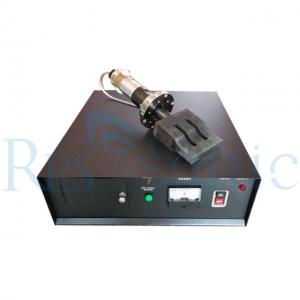

Add to Cart
15Khz 2600W Analog Type Ultrasonic welding machine for plastic welding
Parameter
| Item | Parameter |
| Frequency | 15Khz |
| Power | 2600W |
| Ceramice chips | 4chips |
| Weight | 30kg |
What’s ultrasonic generator?
Ultrasonic generator, usually called ultrasonic power supply. Its function is to convert our mains (220V 110V or 380V, 50 or 60Hz) into a high frequency AC signal that matches the ultrasonic transducer. From the form of the amplifying circuit, a linear amplifying circuit and a switching power supply circuit can be used, and the high-power ultrasonic power source generally adopts a circuit form of a switching power supply in terms of conversion efficiency. Linear power supplies also have their own application range, which has the advantage that the circuit can be not strictly required.
Matching allows the operating frequency to change continuously and continuously. From the current situation in the ultrasound industry, ultrasonic generators are mainly divided into self-excited and separate excited power supply.
The principle of the ultrasonic generator is to first generate a signal of a specific frequency by a signal generator, which may be a sinusoidal signal or a pulse signal. This specific frequency is the frequency of the transducer, and is generally applied to ultrasonic in an ultrasonic device. The frequency is 20KHz, 25KHz, 28KHz, 33KHz, 40KHz, 60KHz,70khz, 100KHz.
working principle
When ultrasonic waves act on the thermoplastic plastic contact
surface, it will produce tens of thousands of high-frequency
vibrations per second. This kind of high-frequency vibration with a
certain amplitude will transmit the ultrasonic energy to the
welding area through the upper weldment. Because the welding area
is two The acoustic resistance at the interface of each welding is
large, so local high temperature will be generated. In addition,
due to the poor thermal conductivity of the plastic, it cannot be
distributed in time for a while, and it gathers in the welding
area, causing the contact surface of the two plastics to melt
rapidly, and after a certain pressure is applied, they are fused
into one. When the ultrasonic stops, let the pressure continue for
a few seconds to make it solidify and shape, thus forming a strong
molecular chain, achieving the purpose of welding, and the welding
strength can be close to the strength of the raw material. The
quality of ultrasonic plastic welding depends on three factors: the
amplitude of the transducer's welding head, the applied pressure
and the welding time. The welding time and welding head pressure
can be adjusted, and the amplitude is determined by the transducer
and the horn. There is an appropriate value for the interaction of
these three quantities. When the energy exceeds the appropriate
value, the melting amount of the plastic is large and the welded
material is easy to deform; if the energy is small, it is not easy
to weld firmly, and the applied pressure cannot be too large. This
optimal pressure is the product of the side length of the welded
part and the optimal pressure per 1mm of the edge.
Pictures
